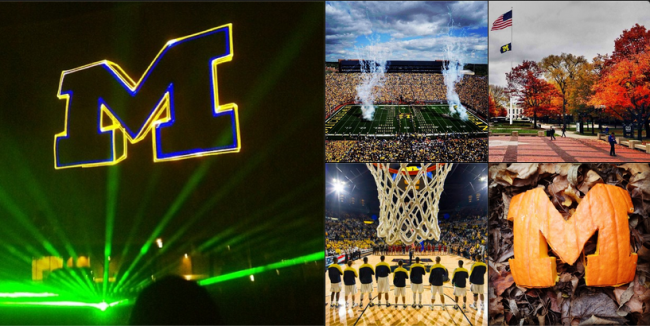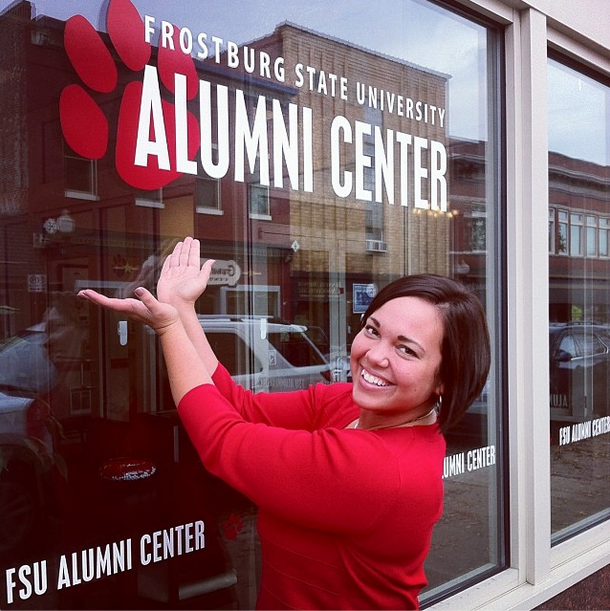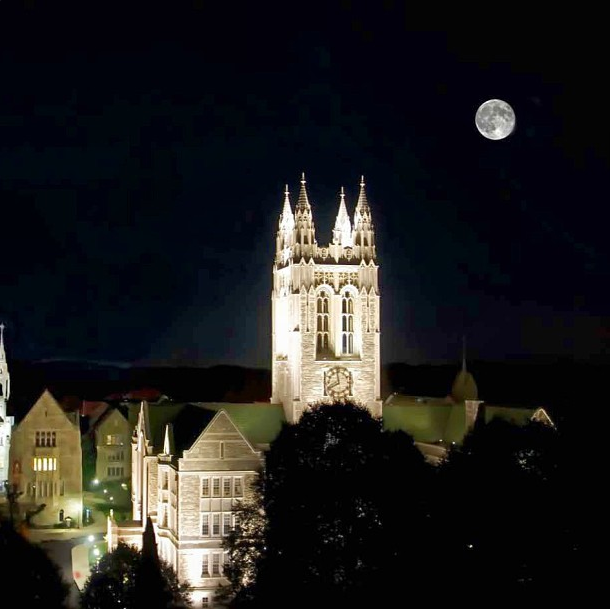You have /5 articles left.
Sign up for a free account or log in.

Images from the University of Michigan's Instagram account.
Keeping up with the latest social media trends is time-consuming even for digital natives, which is why some institutions have outsourced the task to experts in the field. When universities examine how to reach students online, some of the people behind the efforts are often therefore students themselves.
Instagram, the leading mobile photo-sharing app, celebrated its three-year anniversary in October, but it still took many universities until 2012 to create their own accounts. Since then, institutions have used the app mostly to cater to three distinct groups: prospective students searching for a home away from home, current students sharing their own residential experiences and alumni reminiscing about their time on campus.
The app allows users to share video snippets and photos cropped into its distinctive square frame and, usually, edited with an over- or undersaturated filter. With its recent launch on the Windows Phone operating system, Instagram is now available on all three major smartphone platforms, reaching more than 150 million active users. It soaring popularity led Facebook in April 2012 to drop $1 billion (or four times what Amazon's Jeff Bezos paid for The Washington Post) to acquire it.
“Facebook is no longer the solo giant that everybody has to be on,” said Becca Ramspott. a communications specialist at Frostburg State University. “Geographically people are looking for new places to exist.”
College and university Facebook and Twitter accounts may yet boast the highest number of followers, but measured by engagement, social media managers say the attention has shifted to platforms that are optimized for mobile use and excel at one task -- like Instagram with photography, for example. By creating and maintaining Instagram accounts, universities have found a simple -- not to mention free -- way to interact with students where email and other forms of communication could go unnoticed.
“There’s definitely been a decided shift to the more visual mediums,” said Melissa Beecher Lesica, social media manager at Boston College. “Knowing that’s where the students' eyes are right now has informed our strategy immensely.”
At Boston College and many other universities, that strategy involves letting students dictate how the platform should be used -- sometimes to the point where an institution will avoid creating an official account. That’s the case at Frostburg State, which launched a photo crowdsourcing effort in 2011, then waited to see how students would develop it.
“We wanted to learn how people were connecting with Frostburg before we launched our own account,” Ramspott said. “The best way to determine whether some random marketing or branding thing is working is if people are taking ownership of it in ways you didn't originally use it.”
Ramspott monitors the hashtag “#instafrostburg” and shares the best contributions -- pictures of basketball games, fliers advertising campus events and landscape shots, among others -- to other social media platforms such as Facebook and Pinterest, an online pinboard platform. This fall, the university launched the closest thing to an official Frostburg Instagram account: Meet a Bobcat, which profiles faculty members, staff and students.

Hashtags, popularized by Twitter, have become somewhat of a common currency for social media sites. Facebook announced support for hashtags in June, followed by Google in September. A web search for “#highered,” for example, can now produce results from a variety of social media platforms, not just Twitter.
The University of Michigan has hired three student interns to keep up with social media trends. Its Instagram account is mainly handled by Katie Szymanski, a junior communication studies and Spanish major.
“Being a student myself, I feel like I have the upper hand because I’m always on campus, and I’m always going to events,” Szymanski said.
Michigan’s Instagram account has about 23,000 followers and has grown by more than 700 percent in a year, said Hillary Frazier, the university’s social media specialist. Still, that increase is dwarfed by the institution's Pinterest account, which has grown by more than 2,100 percent. The anecdote shows that by the time universities develop effective social media for one platform, their audiences may have moved on.
"You’re always going to be behind," Frazier said.
Szymanski credited the growth of the Instagram account to regular and relevant updates -- she posts two or three times a day. Some recent posts include a collage to ignite school spirit ahead of Michigan's rivalry game against Ohio State University, seasonal shots of campus buildings and marshmallows shaped like the Michigan "M" floating in cups of hot chocolate, among others. The university is also hosting its first Instagram contest in November, inviting students to upload pictures in response to a weekly theme with the hashtag “#MyUMich.”
Other institutions have chosen a less prolific approach. With about 35,000 followers, Boston College runs one of the most popular university Instagram accounts, but it tends to post only once a day.

“I think there’s a lot to be said about a minimalist approach,” Lesica said. “When people are getting too noisy in the stream, I think that’s a turnoff.”
Boston College and Michigan have both decided their Instagram accounts need to do more than show off their campuses. The teams in charge of the accounts will often like and comment on pictures posted by students, which is similar to how some organizations manage their Facebook or Twitter accounts. If followers see the accounts behaving like human beings instead of simply blasting out press releases, they are more likely to interact with them, the theory goes.
“It’s just a very organic back-and-forth, and that’s a big part of it: It’s not just posting the pictures,” Lesica said. “Students really love the fact that Boston College liked their picture.”








